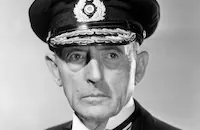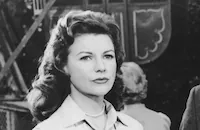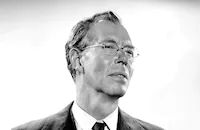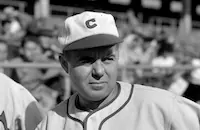Sister Kenny

Brief Synopsis
Cast & Crew
Dudley Nichols
Rosalind Russell
Alexander Knox
Dean Jagger
Philip Merivale
Beulah Bondi
Film Details
Technical Specs

Synopsis
In 1911, Elizabeth Kenny returns to her home in the outback of Queensland, Australia, a recent graduate of a Brisbane nursing school. Although her friend and mentor, Dr. Aeneas McDonnell, advises her to leave the harsh bush and practice in Brisbane, Elizabeth is determined to bring medicine to her needy neighbors. Two years later, during a dance held in her honor, Elizabeth is called away to treat an ill child, Dorrie McIntyre. Dorrie's legs are severely cramped, and her back is arched in writhing pain. As Elizabeth does not know how to diagnose Dorrie, she cables McDonnell, carefully describing the child's symptoms. McDonnell cables back that Dorrie is suffering from infantile paralysis, a newly discovered, epidemic disease for which there is no known cure. Taking McDonnell's advice to treat Dorrie's symptoms as best she can, Elizabeth applies hot, wet rags to the child's twisted legs and back. Although Dorrie's pain immediately abates, Elizabeth discovers when she returns ten days later with her fiancé, army captain Kevin Conners, that Dorrie's legs are paralyzed. Determined to cure Dorrie, Elizabeth studies her limp legs and notices that a tendon on top of her knee protrudes when the limb is bent. As Kevin and Dorrie's parents watch anxiously, Elizabeth declares that some of Dorrie's leg muscles have become "alienated" from her brain and instructs the child to move her leg by concentrating on her knee. To everyone's relief, Elizabeth's treatment works, and soon Dorrie and the five other stricken children she is attending are walking again. Fresh from her triumph in the bush, Elizabeth goes to Brisbane with Dorrie and Kevin to inform McDonnell that she and Kevin are marrying. Before she breaks the news, however, she stuns McDonnell when she tells him about her incredible success with the polio epidemic. Excited, McDonnell takes her to see his superior, orthopedic specialist Dr. Charles Brack. When Elizabeth uses the words "spasm," "alienation" and "re-education" to describe her treatment, Brack dismisses her as a well-meaning amateur and intimates that her original diagnosis was incorrect. McDonnell tries to convince Brack to allow Elizabeth to treat one of his acutely affected polio patients, but he flatly refuses to give her a chance. Still supportive of Elizabeth, McDonnell suggests that she treat one of Brack's discharged patients as a way of proving her methodology to Brack, but Elizabeth tells him that she is getting married and, because of an Australian law that says that nurses must be single, will be unable to pursue her career. Sometime later, however, the still unmarried Elizabeth opens a clinic and begins curing Brack's failures. Kevin's departure for World War I curtails her clinic activities, as she chooses to follow him to the front and then to England, where he recuperates from an injury. While she is away, McDonnell makes an unsuccessful attempt at using her methods on one of Brack's patients and is soundly criticized by his superior. Elizabeth, meanwhile, reiterates to Kevin her desire to marry, but soon finds herself opening a clinic in her home town. Ten years later, Elizabeth, whose popular reputation is growing around the country, finally admits to Kevin that her profession is more important to her than marriage. After another decade, Elizabeth grows weary of her continuing back-door status and confronts Brack as he is giving a lecture on polio. The enraged Brack ridicules her and threatens to have her clinic closed down. McDonnell, however, has been working to have her treatment recognized by the Australian medical community and has arranged for a royal commission to study it. When Elizabeth expresses doubts over her chances, McDonnell insists that the "walls of Jericho" will soon be falling down and encourages her to continue. While the commission takes its time preparing its report, Elizabeth travels to England and other parts of Europe with her cure. Upon her return to Australia in 1939, she learns from McDonnell that the commission has ruled that her methods are not provable and has recommended closing down her clinics. Despite a worsening heart condition, Elizabeth, who has since written a book about her experiences, tells McDonnell that she is going to America. There Elizabeth receives a mixed reception by the press and medical community, but is invited to open a clinic at the University of Minnesota. Three years later, while lecturing at her Kenny Institute on her birthday, Elizabeth learns not only that her beloved McDonnell has died, but also that yet another commission has refused to validate her. Despite this setback, Elizabeth finds comfort when a large group of her young patients joyously sing her birthday wishes.

Director

Dudley Nichols
Cast

Rosalind Russell

Alexander Knox

Dean Jagger

Philip Merivale

Beulah Bondi

Charles Dingle

John Litel
Doreen Mccann

Fay Helm

Charles Kemper

Dorothy Peterson

Gloria Holden
Virginia Brissac

Frank Reicher
Paul Stanton

Charles Halton
Allen Lee
David Martinson

Lloyd Ingraham
James Loucke
Earl Dobbins
Teddy Infuhr

James Burke
B. G. Norman
Harry Mckim
Vincent Graeff
Jackie Pfendler
Orley Lindgren

Nan Leslie

Ellen Corby
Anne O'neal
Connie Lamont
Mary Gordon
Myra Nelson
Mary Bayless
Bertha Ledbetter
Elena Warren
Betty Gillette
Betty Fairfax
Ruth Lee
Gloria Donovan
Diane Nance
Nora Lee Norman
Melinda Erickson
Monica Folts
Sue Ann Hockett
Karolyn Grimes
Hilda Plowright
George Noakes
Robert Templeton
Egon Brecher
Charles Hall
Francis Ford
Dave Thursby

Walter Baldwin
Nellie Walker
Jennifer Cook
Judy Cook
Charles Pawley
Lumsden Hare
Clare Verdera
Len Hendry
Warren Jackson
Eddie Hart
George Barton
Carl Hanson
Alf Haugan
Sam Harris
Ray Toone
Jackie Curry
Al Choals
David Hughes
Dick Bartell
Warren Smith
Franklyn Farnum
John Moss
Tommy Kingston

Ray Walker
Larry Mcgrath
Mischa Gutterson
Wilda George
David Levitt
Bob O'connor
Beulah Hubbard
Edith Conrad
Connie Conrad

Gertrude Astor
Bonnie Blair
Daphne Moore
Lee Bonnell

Regis Toomey
Charles Dorety

Edward Keane

Eddie Kane
Dick Scott
Harry Flannery
Alan Ray
Sam Lufkin
Ely Schmuckler
Bobby Hale
Joe Bernard
Vivian Oakland

Ralph Dunn

Brandon Hurst
Barbara Smith
Bruce Brewster
Tex Swan
Bob Pepper
Irene Mack
Jane Allen
Sally Cleaves
Leota Lorraine
Mamie Henderson
Ivy Lane
Patricia Berry
Jean Criswell
Robert Strong
Donna Lynne Rodgers
John Wade
Nancy George
Ruth Miles
Clara Griggs
Crew
C. Bakaleinikoff
Travis Banton
George Barnes
John Burch
Albert S. D'agostino
Harry D'arcy
C. J. Davis
Edward Donahoe
Lynn Dunn
Paul Eagler
William E. Flannery
Jack Gage
Roland Gross
Valerie Harvey
Alexander Knox
Mary Mccarthy
Harley Miller
Earl B. Mounce
Dudley Nichols
Dudley Nichols
Clem Portman
Edwin L. Pyle
Darrell Silvera
Al Simpson
Alexander Tansman
Vernon L. Walker
Earl A. Wolcott

Photo Collections
Videos
Movie Clip



Trailer
Hosted Intro
Film Details
Technical Specs

Award Nominations
Best Actress
Articles
Sister Kenny
Often traveling with Kenny and watching her work, Russell grew to admire her more and more. "I believe if she hadn't gone stamping through the world, stirring people up, we'd have been a whole lot longer getting the Salk vaccine," the actress wrote. Kenny, observing Russell's toddler son Lance in the bath during a visit to the actressåÀome, noticed a spastic muscle in his right leg and had the child admitted to her Kenny Institute in Minneapolis under a false name. Little Lance, who had been unable to walk before, left the clinic walking normally.
Sister Kenny, developed by three screenwriters (including co-star Alexander Knox) from Kenny's autobiography, offers Russell a tour de force that takes her character from college days to age 60. After first encountering the ravages of polio in the outback, Kenny evolves a theory of treatment that is scorned by the medical community but eventually proves so successful that, after arriving in the U.S. in 1940, she sets up her own institute. The men in Kenny's life are played by Dean Jagger, as the romantic interest she leaves behind in her dedication to work; and Knox as a Scottish physician who believes in the nurse's ideas despite the opinions of his fellow doctors.
Russell's close association with her subject allowed her to observe many details that she wove into her characterization. "I studied her walk, her gestures," the actress wrote in her autobiography. "She had a very powerful right hand, a very feminine left hand, and she stood very straight because her mother had kept a back brace on her as a child."
Sister Kenny brought Russell the second of four nominations for an Oscar, which she never won in competition - though she was given the Academy's Jean Hersholt Humanitarian Award in 1973. Her other nominations were for My Sister Eileen, 1942; Mourning Becomes Electra, 1947; and Auntie Mame, 1958. Russell did win five Golden Globes, including one as Best Dramatic Actress for Sister Kenny. Daily ads in the Hollywood trade papers had promoted Russell for the Oscar that year, and she was the only one among the 10 acting nominees to keep running ads after the nominations were announced. Despite these efforts, Russell lost the statuette to Olivia de Havilland for To Each His Own (1946).
Producer: Dudley Nichols, Edward Donahue (associate)
Director: Dudley Nichols
Screenplay: Alexander Knox, Mary McCarthy, Dudley Nichols, from the book And They Shall Walk by Elizabeth Kenny and Martha Ostenso
Cinematography: George Barnes
Art Direction: Albert S. D'Agostino, William E. Flannery
Costume Design: Travis Banton
Original Music: Alexander Tansman
Editing: Roland Gross
Principal Cast: Rosalind Russell (Sister Elizabeth Kenny), Alexander Knox (Dr. Aeneas McDonnell), Dean Jagger (Kevin Connors), Philip Merivale (Dr. Brack), Beulah Bondi (Mary Kenny), Charles Dingle (Michael Kenny), John Litel (Medical Director).
BW-117m. Closed captioning.
by Roger Fristoe

Sister Kenny
Quotes
Trivia
Notes
According to modern biographical sources, the real Elizabeth Kenny, like the film character, began practicing as a nurse in Australia in 1911. Contrary to the film, however, she had received no formal training in nursing. She worked in the Australian army nursing corps between 1915 and 1919. In 1933, she established a clinic in Townsville, Queensland, and opened a clinic in England in 1937. Her Minneapolis clinic was opened in 1940. Kenny died of a stroke in 1952 after suffering for years from Parkinson's disease. The term "sister" is used in Australia to denote military nurses. Archer Winston of the New York Post noted in his review of the film, as quoted in Hollywood Reporter, that according to an orthopedic specialist he interviewed, Kenny's method had not been accepted by the medical community and that its results were "in no way distinguishable from those of customary physical therapy." Other reviewers also commented that despite Kenny's claims, her methodology had not been proven obviously superior to more conventional treatments. Modern assessments of her techniques are more generous; actor Alan Alda attested in a modern interview that he was cured of polio as a child using the Kenny method. With money she earned from a stretcher patent, Kenny financed her clinics herself and never, according to biographical sources, profited from her practice.
The idea for a film version of Kenny's life began years before the picture was actually made, although accounts of its inception differ. According to a November 1943 Los Angeles Daily News article, screenwriter Mary McCarthy first got the idea in late 1942 after reading a biographical account of the nurse in Reader's Digest. (Two Reader's Digest articles were actually published about the nurse in December 1941 and October 1942). McCarthy then convinced a reluctant Kenny to cooperate, agreeing to her stipulation that the film would cover adequately Kenny's moist pack treatment and early physical therapy. After securing Kenny's permission, McCarthy brought an outline she had written to Rosalind Russell, who was Kenny's choice for the title role, and Russell in turn approached then RKO vice-president Charles Koerner with the idea. According to a September 1942 Hollywood Reporter news item, Milton Gunzburg was to collaborate with McCarthy on the screenplay, but his contribution to the completed film, if any, has not been determined. In the November 1943 Los Angeles Daily News article, David Hempstead was announced as the film's producer, and Edward Dmytryk as director. The production was to begin filming in late December 1943. According to various September 1946 news items, however, it was Russell who initiated the film biography. Russell financed a documentary film about the Kenny method in 1942 after reading a magazine article about her and traveled around the country with her. She then reportedly spent three years pitching the idea of a screen biography to Hollywood producers. After being turned down by L. B. Mayer, Darryl F. Zanuck, Jack L. Warner and others, who claimed the story had no box office appeal, Russell convinced Koerner to back the proposal.
A November 1943 New York Times article noted that RKO bought the story rights from Kenny for $100,000 after an option acquired by Benedict Bogeaus, a United Artists' producer, had expired. Kenny donated the $100,000 to a trust for her seventeen nephews in the Australian Air Force. The same article added that the picture was budgeted at $1,200,000 and that Kenny stipulated in her contract that Russell would play her.
Although Hollywood Reporter announced in February 1944 that Clifford Odets was to do a polish of the screenplay, Dudley Nichols was brought in as the picture's writer and producer in April 1944. Odets' contribution, if any, to the completed film has not been determined. In May 1944, Hollywood Reporter announced Jean Renoir as the film's director. Actor Philip Merivale died on March 12, 1946, prior to the film's release. RKO borrowed Alexander Knox from Columbia for the production. According to Hollywood Reporter, Kenny supervised Rosalind Russell during makeup and wardrobe tests. Technical advisor Valerie Harvey was a nurse technician who worked with Kenny, according to Los Angeles Daily News. Hollywood Reporter noted that Broadway star Francesca Bruning was to make her screen debut in the role of "Mrs. McIntyre," the part played by Fay Helm. July 1946 Hollywood Reporter news items announced that Kenny was going to back out of attending the New York premiere of the picture so that she could help out during a polio epidemic in Minneapolis. By mid-September 1946, however, Hollywood Reporter reported that Kenny and a "group of Minneapolis civic leaders" would be attending the premiere. According to modern sources, the picture lost $660,000 at the box office. Russell was nominated for an Academy Award for her performance in the picture.
















